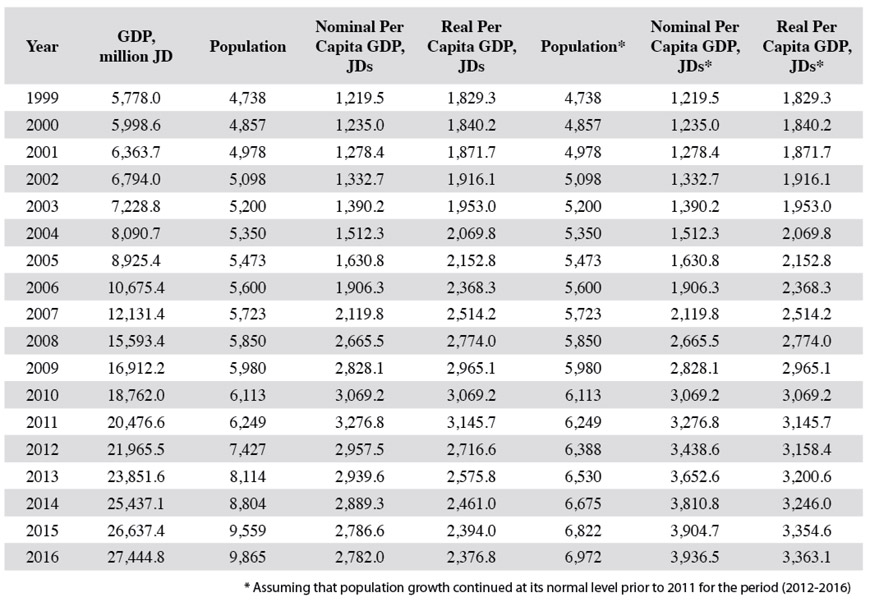Per capita GDP is a measure of average income in a given country. It is calculated by dividing nominal GDP by the country’s population (citizens and non-citizens).
Although, this indicator is far from being perfect in measuring people’s standards of living and lifestyle, it is still used to compare changes of average income over time for the same country, and in comparing one country to another.
In Jordan, the issue of per capita income is being raised from time to time without a complete analysis of the main developments that took place over the last few years.
This report wishes to shed some light on these developments. It covers the period 1999-2016, i.e., during the reign of His Majesty King Abdullah.
The analysis includes nominal and real per capita GDP.
Nominal per capita GDP
Statistical figures show that per capita GDP in nominal terms more than doubled (2.3 times) during the said period. A thorough analysis shows that we had two periods of contrasting results: the first, 1999-2011, before the Arab Spring, the second 2011-2016.
During the first period, nominal per capita continuously increased, though by varying percentages; on average it increased by 8.1 per cent annually.
It reached JD3,276.8 in 2011, while it was JD1,219.5 in 1999.
During the second period, nominal per capita GDP fell, on average, by 3.2 per cent annually, to reach JD2,782.0 in 2016.
This steady decline during the second period has been caused by two main factors; the abnormal increase in population, caused by the influx of refugees, and economic slowdown.
On average, population grew by 9.7 per cent annually during this period, while nominal GDP grew by an annual rate of 6 per cent.
Had population continued to grow at the rate prevailing prior to 2011, per capita GDP could have reached JD3,936.5 per year in nominal terms and JD3,363.1 in real terms in 2016.
This would have been 3 times and 1.8 times, respectively, higher than their levels of 1999.
Real per capita GDP
This indicator is more accurate to gauge the improvement or deterioration of people’s standards of living, since it measures the purchasing power of income.
A close look at the data for the 1999-2016 period shows that real per capita GDP rose 1.3 times, to reach JD2,376.8 per annum, in 2016, compared to JD1,829.3 per annum in 1999.
As in the case of the nominal per capita GDP, two periods of contrasting outcomes are obvious.
The first period, 1999-2011, witnessed a continuous increase of real per capita GDP by an average of 4.3 per cent annually, while the second period, 2011-2016, saw a reversal of this trend.
During the first period, real GDP per capita increased from JD1,829.3 per annum in 1999 to JD3,145.7 per annum in 2011.
In the second period, real per capita GDP fell by 5.3 per cent annually; it reached JD2,376.8 per annum in 2016.
The main factors that led to this outcome are also the abnormal increase of population caused by the influx of refugees, the economic slowdown and inflationary pressures during the 2011-2013 period.
If the population growth for the period 2012-2016 had continued at the same level it had witnessed before 2011, real per capita GDP would have reached JD3,363.1 per year in 2016.
That would have been almost double (1.8 times) its level 1999.
It could be concluded that the Jordanian economy and the per capita GDP were on the right track, but were disrupted by the regional developments taken place since 2011.
Nominal per capita GDP would have increased more than 3 times during 1999-2016 had the population growth continued at its level before 2011.
Despite all the mentioned developments, per capita GDP has increased 2.3 times in nominal terms when comparing 2016 (JD2,782.0 per year) to 1999 (JD1,219.5 per year), while in real terms, the per capita GDP rose 1.3 times during the whole period (1999-2016).
The writer is director at the Research Department at the Social Security Investment Fund. He previously served as senior economist at the IMF. He contributed this article to The Jordan Times.

